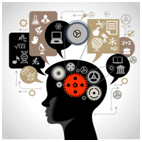
Shiny shoes, smart uniform, brand new suitcase packed with learning materials, all the outward signs of your child’s readiness for school when the new year begins. But, is he ready to cope with the demands of school and start the formal learning process? A child’s readiness for school encompasses a range of skills which develop during the critical first five years of his life, long before school starts. He needs to be prepared physically, socially, emotionally, and have good cognitive, language and perceptual abilities, in order to achieve and thrive in the school environment. Readiness is not a static state in the child’s development, but is an ongoing process, which is enhanced by the support and stimulation of the people in the child’s world. On a physical level, the child should be able to perform a variety of gross motor tasks, such as climbing, skipping and catching a ball, with confidence. His fine motor abilities should include cutting with scissors, drawing and being able to use cutlery while eating. Both gross and fine motor abilities are dependent on hand-eye co-ordination. The child’s social and emotional development is the foundation for cognitive development. Can he adapt easily to new social situations? Can he complete tasks on his own without constantly seeking adult assistance? How does he interact with others, both adults and children? Is he confident and self-assured? Does he show responsibility? Can he solve problems and cope with emotional situations in a mature manner for his age? A child’s school performance...








